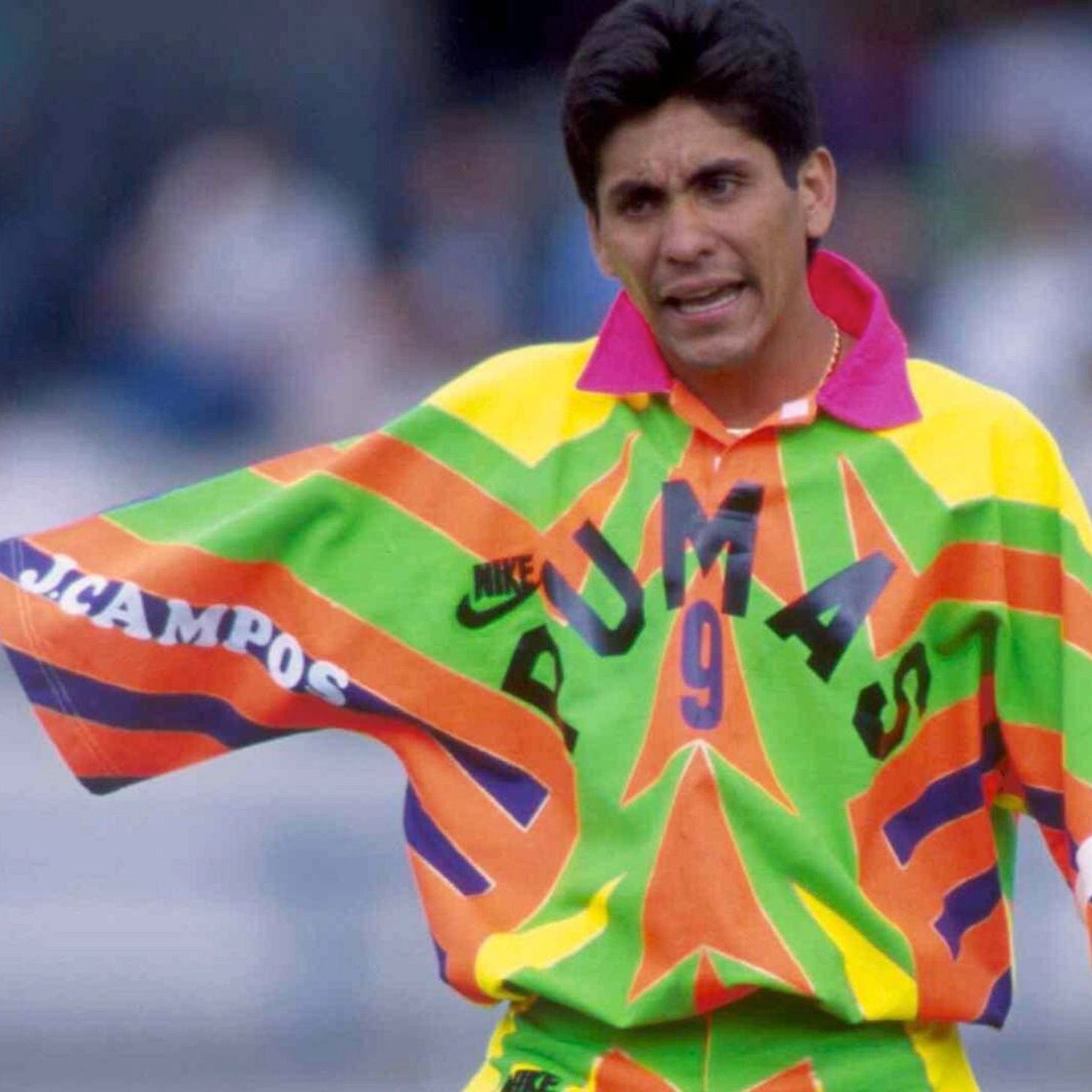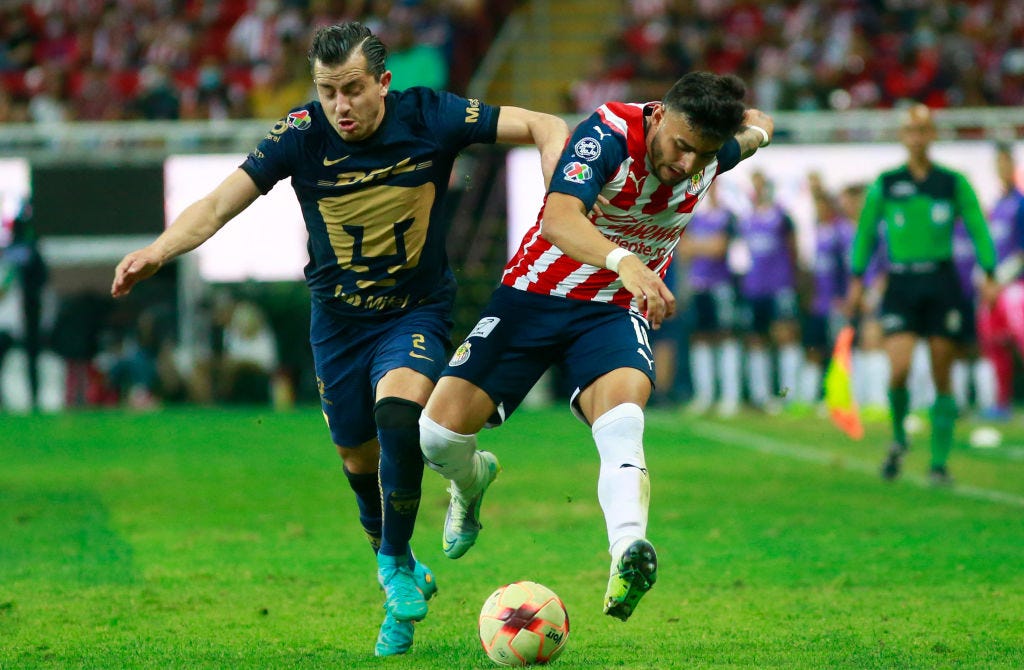🐾 What to know about Pumas (and the Sounders) ahead of the CCL final
A wide-angle view of the clubs looking for glory
Big night tonight with the Mexico-Guatemala friendly serving as the appetizer to the CCL final first leg main course.
I’ll send a thread at 6:45p Central or so if you want to toss some questions at me, sound off on the night or just hang with the Getting Conca-mmunity.
Ahead of the Concacaf Champions League final first leg tonight, I thought it would be instructive to take a big-picture look at both teams, talking about their history, their present and what a title would mean for their future.
So…what’s the deal with Pumas?
You’ve seen the iconic Pumas logo, one of the best in sports on jerseys, on bumper stickers, on throwback merch. I could fill the whole newsletter with vibe-y pictures of the glory days, and you’d probably enjoy it more than whatever I write.
But you’re here to learn something, dammit.
Pumas are affiliated with UNAM, the biggest university in Latin America. Its Mexico City campus is filled with history, the library painted by Juan O'Gorman is a UNESCO World Heritage site and the stadium itself has a mural painted by Diego Rivera on the side.
When speaking about Pumas, that history often comes to mind. The glory days of Hugo Sanchez when Pumas won two league titles and one of three Concacaf Champions' Cups, the predecessor to the modern-day CCL. Jorge Campos was deployed both as brightly dressed shot-stopper and, occasionally, as a forward as Pumas won another league crown in the early 90s and added to their Concacaf trophy case.
But so many of the pictures of Pumas’ celebrations now look yellowed by age. There have been four league titles since 2000, but Pumas’ current successes are much more flashes in the pan than simmering, sustained fires.
Unlike, say, Tigres, their affiliation with the university goes beyond simply playing on campus and keeping cultural ties in tact. While Tigres now are backed by cement-giant CEMEX and are able to reap the rewards of corporate backing, Pumas still is dependent on an institution that, while enormous, often still needs to prioritize its educational aims rather than the Liga MX team playing on campus.
That means Pumas often have to make transfers they might not want to, including sending forward Carlos Gonzalez to Tigres a few offseasons ago or moving promising Mexico U-23 midfielder Erik Lira across town to Cruz Azul this winter.
That has meant that, while other ‘grandes’ like Chivas trumpet their academy success, Pumas has needed to toss their young players into the fire, sometimes even sooner than other development clubs.
That hasn’t always gone well with fans (of which there are many) who still yearn for the frequent celebrations of days of yore.
When it comes to playing players developed by the club, “nobody cares,” Rodrigo Ares de Parga, who works as Pumas president, told ESPN in 2021. “The only thing that matters is the result. I didn’t get it. I bet on the future, not the present,”
But, of course, Pumas now are reaping the rewards of Ares de Parga putting that focus on the young players coming through.
Right back Alan Mozo and left back Efrain Velarde are former academy players likely to start in the CCL final, while midfielder Omar Islas and defender José Galindo are likely to feature.

Pumas also has been a launching pad for players who form the base of the national team, with Hector Moreno, Jesus Gallardo (academy products) and Johan Vasquez (who developed in Monterrey but took the next step with Pumas) among those who are no longer with the club but will represent El Tri at this summer’s World Cup.
Sales of players like Lira and Vasquez allow Pumas to utilize its South American scouting network to sign players like Juan Ignacio Dinenno, the talismanic forward who has scored seven goals in the CCL so far.
The Argentine is likely to miss out on the first leg with a muscle injury in his right leg, but he represents the type of player Pumas now relies on in addition their academy players. A Rosario native, Dinenno had bounced around South America, performing well outside his native country but never putting it together for Racing. Pumas brought him in ahead of the 2020 campaign and it’s been a perfect marriage, with Dinenno putting his heart into the club, yelling the university-inspired “Goya” chant before and after games and scoring dozens of goals for the club.
He’s unlikely to stay as long as a club legend like Dario Veron, the Paraguayan enforcer who came to Mexico City from Chilean club Cobreloa and left after more than 450 matches with the Universitarios.
But one South American who perhaps will extend his stay is Andres Lillini. In a similar vein as Dinenno, the Argentine manager achieved little in his home country but after several years working with Pumas youth teams, he was tossed into the hot seat after Michel left suddenly just before the resumption of play in summer 2020.
The team made it all the way to the final, with Lillini managing to get the team to play greater than the sum of its parts. He has used both widely accepted tactical philosophies from top European managers (Mozo tucks in from his right back spot to become another midfielder or underlaps the winger to become another attacker in the final third) and basic wrinkles (Favio Alvarez working in the in-between role sometimes as a 10 but more often as a traditional second striker).
At times, it seems like Lillini himself still can’t believe he’s doing this job or coaching in this type of match. The 47-year-old wears his emotions on his sleeve, sometimes getting fiery on the touchline but just as often being moved near tears or giving his players and staff big ol’ hugs after triumphs.
“We’re very motivated. I’m enjoying it a lot, and I see it as a very privileged situation. I enjoy everything I’m doing,” he said yesterday in the pre-match news conference.
For Pumas, currently on the brink of the playoffs in league play, the CCL final goes far beyond extending Mexico’s hegemony in the tournament. It’s about putting that famous logo back on the world stage for something happening now, not something that happened decades ago.
Ya se, pero que me puedes decir de los Sounders, cabron?
While these current Sounders in MLS started play in 2009, the club traces its history to the 1970s when a team called the Sounders started to play in NASL.
Whether or not it comes from a foundation built on the 1982 NASL championship, the Sounders quickly became a reference for the league.
With a fervent fan base, a willingness to spend to bring in the right players scouted from Latin America, and a clear tactical identity, the Sounders are the model MLS franchise.
And their fans will let you know about it, too.
While the “Seattle invented…” meme has faded as new and nosier kids have appeared on the block, the fact that Seattle may be able to sell out NFL stadium Lumen Field for the second leg shows their reputation as a soccer city is well-earned. And, well, it’s a big deal.

The Sounders can’t claim the same type of player development success Pumas can but already can point to players like DeAndre Yedlin and Jordan Morris as academy prospects who have become internationals.
Their most important ‘homegrown’ may be Brian Schmetzer, a former NASL Sounder who was on the assistant coaching staff for more than a decade but now has a pair of MLS Cup wins (in four finals appearances) and has his club on the doorstep of becoming the first-ever MLS team to lift the CCL trophy.
He has been able to blend players like Morris and the Roldan brothers in with South American stars like forward Raul Ruidiaz and No. 10 Nicolas Lodeiro to put together a squad that often shows the best of MLS. That he’s also able to get results when he need to throw players like 23-year-old defender Jackson Ragen into the mix speaks to how well-drilled he has players on his ideas and how well the rest of the team can elevate to cover the few weaknesses the roster seems to have. But he also has those stars totally bought in.
“It’s the most important tournament of my career. I don’t want to let this chance go by - nobody wants to let this chance go by,” Ruidiaz told Niko Moreno in Mexico City. “Everything depends on us to achieve what we all want so badly.”

A pair of losses in MLS play have raised some concern, but it’s worth noting that Pumas aren’t lighting the league on fire either. Playing - and winning - in CCL takes effort.
The focus is on that continental crown, one that will mean everything to the team that lifts it, whether it’s Schmetzer doing so as the first MLS coach to put his paws on it or Lillini, once again letting his emotions show.
See you tonight on the community thread & tomorrow for the Leg One breakdown!








Thanks for the history lesson. My knowledge of Liga MX is so little; this is helping a lot. Cheers.
Jon, you’re the man! Appreciate the newsletter!